

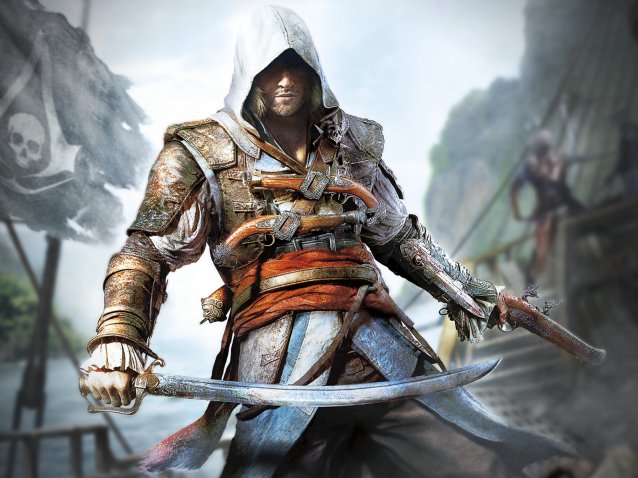
I will be the first to admit that I was apprehensive when I sat down to play the demo for Assassin's Creed IV: Black Flag at this year's PAX Prime. As a long time fan of the series I had a slight sense of nepotism going into Assassin's Creed III, a game that, in the end, left me with much to be desired. ACIII promised to be different; it paraded its distinctive theme set in the Revolutionary War, a profound historical event not often explored in the world of gaming. While traversing the open world of 18th century America was indeed a novelty in the series, the overall gameplay was not as fresh, featuring much of the same combat and tactics found within its five predecessors. Repetition was becoming a reoccurring problem within the series. At this point it was not a narrative makeover Assassin's Creed needed to revitalize itself… it was gameplay.
Enter Assassin's Creed IV: Black Flag, which provided a hands-on demo that I began with slight trepidation and ended with sheer anticipation. My adventure as the rugged Edward Kenway begins on his ship, the Jackdaw, which is coasting elegantly over the emerald waters of the Caribbean Sea. Using the right stick to pull up the map I can see the enormity of the world director Ashraf Ismail and the Ubisoft team created. The map, which seems to span for miles, displays areas of sea and land that are littered in icons, each one representing a unique escapade that varies from harpooning missions and asssination contracts to ships, cities, and diving locations. Ubisoft was spot on in claiming that this is a sandbox title—and it appears to be one in which the player will never be bereft of things to do. Yes, previous titles within the series had extra missions and markers scartted across the game, but nothing to the extent or variety of what is seen on this map. There is so much more to this game than just generic "FedEx" feather or flag collecting.
Placing a marker on the map and shifting to full sail, I decide to try out Edward's hands at a harpooning mission. For those who are accustomed to the controls of the ship missions in ACIII, the overall dynamics of Jackdaw will be familiar enough to pick up with ease. However, those who disliked the ship missions will be happy to know that controls are massively upgraded from their predecessor, providing a more organic and responsive experience that allows for open world travel.
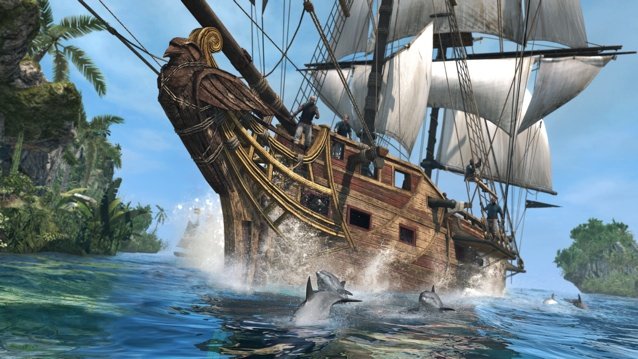
As I pick up speed it becomes easy to see that the Caribbean is a living and breathing environment. The waves of the ocean crash into the side of the Jackdaw, bobbing the boat up and down in their unrelenting wake and providing a glimpse of just how detailed the physics engine of this game truly is. Along the way I encounter some stragglers who can be rescued to join the Jackdaw's hefty crew, small islands that can be searched for treasure, and a variety of ships sailing to and from different ports, indicating the richness of the economy within the game.
Using spyglass, Edward is able to analyze each nearby ship for their level and cargo. Eventually the Jackdaw stumbles upon a small and rather unfortunate level 4 Schooner. We decide to use it for practice; after all, pirates. To enter combat, I slow down by lowering the main sails and fire upon the Schooner. Using the cannons on the Jackdaw is dependent upon the direction you look, providing a much more straightforward feel for the player. Turning to the left or right of the Jackdaw will allow us to fire the broadside cannons, facing the front allows us to use trajectory based front cannons, and facing the back allows us to drop fire barrels, which explode when fired upon. In attempt to run, the Schooner begins to drop fire barrels, but it is to no avail. With the upgraded Jackdaw I am able to catch up and hit the Schooner with a burst of the powerful broadside cannons, leading the small ship to sail back over its own barrel, which explodes with a single shot of the front cannon. As my heart-rate slowed I felt some semblance of a moral pinch as I watched the Schooner sink into the depths of the ocean, but once I heard the cheers of my crew and snatched the cargo from the ship's remains I was awash with satisfaction. Achievement aside, it is important to note that sometimes sinking a ship in ACIV may not be the most practical option, as many of the ship's supplies are then wasted. Ismail explained that when you successfully board and commandeer a ship you can add the ship to your fleet, take its lumber to repair the Jackdaw, or recruit their crew as your own. Lucky for us, boarding is just as rewarding as sinking in terms of entertainment.
After passing a massive Man-O-War (which I decided to pass on given its high level) the Jackdaw approaches two more ships. Here I decided to try our hand at boarding. Each ship, when fired upon, has a health indicator that appears over their mast. Once that indicator turns red the ship is then fair game for boarding from the Jackdaw, though it is also important to note that Edward can even jump off the ship, stealth swim over to the neighboring vessel, and annihilate everyone on board before his crew even arrives.
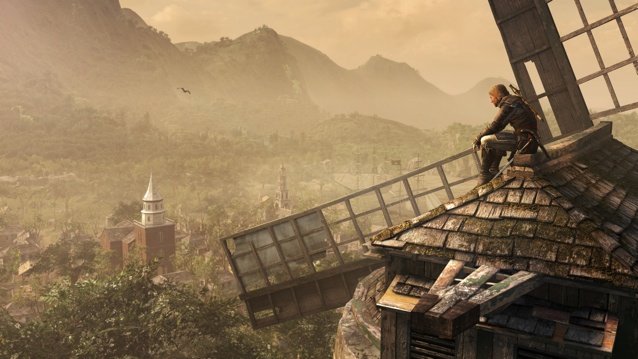
For the moment, I decide to have Edward board using the Jackdaw--a process that has to be timed with accuracy. Too much firing, and you destroy the ship. Too little, and you risk getting destroyed yourself. Once the enemy vessel is in the red zone and the ship is de-masted I approach it on its broad side. With the press of a button the crew immediately begins to launch ropes towards the ship and the boarding ensues. Amidst the fray of battle I am able to lead Edward to the mast of the other ship and drop down, assassinating two men in the process. This is where I could see the ground combat truly shine. The combat in ACIV proves to be more intricate than the previous titles, and personally I think that is a fantastic thing. Yes, I did almost perish in attempt to commandeer the ship and yes it is more difficult, but the combat proves to be a solid juxtaposition of fun and strategy. Rather than simply holding down block to counter, enemy movement needs to be watched and counter attacks have to be planned accordingly. The land combat within the series has grown less redundant since Brotherhood was released, but it seems like ACIV has finally corrected the recurring button-hold mistakes of the past.
After exploring what seems to be only a fraction of the adventures offered within the game, I finally reach our harpooning mission. When prompted, Edward and his crew cast off in a small row boat. Luckily this time around the weather is clear, but Ismail points out that this event is dynamic in that it can occur in any sort of climate. Within seconds, a large shadow grows underneath the boat, exposing the silhouette of massive Hammerhead Shark. Once the Hammerhead surfaces Edward is able to toss a harpoon through its torso; when the shark is struck, a fight initiates that is not unlike the Del Lago fight from Resident Evil 4. Startled and relatively pissed off, the shark incessantly drags the boat and forces us to continue to toss harpoons at its back. At one point it even breaks free, dives under water, and attempts to ram the boat. Once the process of harpooning is repeated Edward finally bests the beast.
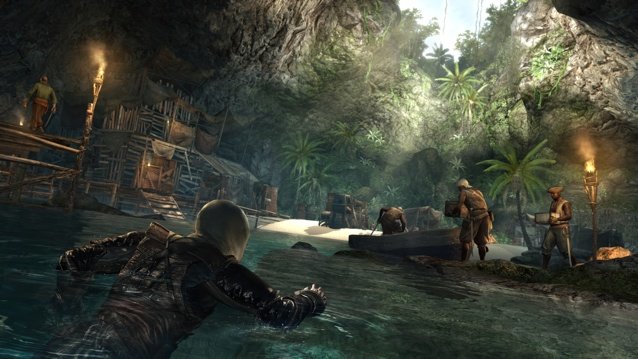
It was finally time to put Edward’s varying talents to use on land in a nearby fishing village. The small village, which housed a few shops and contracts, was the perfect place to try out the stealth mechanics of the game. Despite the open atmosphere of the Caribbean, ACIV provides an extremely detailed environment that makes stealth a tactical and smooth endeavor. I start with the ever-so idiosyncratic hidden blade, which Edward effortlessly slides into his first victim before pulling his lifeless body into the nearby bushes. Immediately I jump to the next victim, dragging them to their veiled death before drawing the attention of other guards. An alerted guard runs over to investigate. I shoot him with the Berserk Poison dart and watch in the shadows as he loses his sanity, attacks his allies, and eventually kills himself. In this respect the stealth gameplay feels familiar. Edward can climb, blend, and work with the environment around him, using it to his advantage. If the stealth gameplay is this well-polished in an open environment, it will evidently shine in the larger cities of Havana, Nassau, and Kingston.
As our demo comes to a close a storm blows across the open ocean and suddenly the entire environment reacts to it--wind brushes the trees and the waves begin to swell. Ismail warns us that it is probably best to not go back out to sea during these storms, and considering the size of the waves, it is easy to see why. Ultimately, the dynamic world Ubisoft has created a stunning and animated setting that actually both reacts to and affects the player's overall actions.
I went into Assassin’s Creed IV: Black Flag not really knowing what to expect, as I truly believed the series was trapped in a loop of repetition. However, after playing the demo I cannot express the excitement I have for the title. My heart raced during ship combat and boarding, my mind churned at the strategic elements in ground combat and stealth. And the best part? These experiences were not even part of the main storyline. The game is rich in every sense of the word—from the vibrant environment and battles to the detailed commerce and leveling systems, AC IV is revitalizing the entire series with an experience not seen or felt since the first title.
Assassin’s Creed IV: Black Flag will be hitting the shelves in North America for Xbox 360, PS3, and Wii-U on October 29th. It will also be released for PC, Xbox One, and PS4.




 The Talos Principle Walkthrough
The Talos Principle Walkthrough Left4Dead, Bioshock and Zelda Chibi Stickers
Left4Dead, Bioshock and Zelda Chibi Stickers Sleeping Dogs Walkthrough
Sleeping Dogs Walkthrough Here's How To Get The Rare Poison Sword Kremvh's Tooth In Fallout 4
Here's How To Get The Rare Poison Sword Kremvh's Tooth In Fallout 4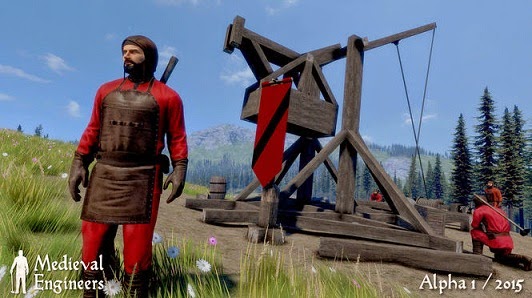 Medieval Engineers (PC) Crafting Guide
Medieval Engineers (PC) Crafting Guide